Catholic Customs
 |
 |
 |
 |
 |
 |
 |
Celebrating Ascension Thursday
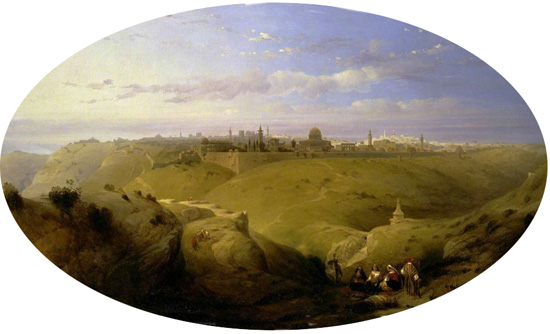
Contemplating Jerusalem from the Mount of Olives
on Ascension Day
Medieval dramas for the Ascension
The great hour of Our Lord's triumph took place when the sun was at its highest: noon. In the early centuries of the Church, a solemn procession used to be made in Rome at noon leading from the Lateran Basilica to a church outside of the city's walls where the Gospel of the Ascension was read and special prayers said.

A Christ statue was hoisted through the roof
These examples soon inspired similar processions throughout Christendom, especially in Central and Western Europe where dramatic embellishments were added to the processions and liturgy in the 10th century. In German churches, when the words of Our Lord Ascendo ad Patrem ("I go up to the Father") were chanted during the Gospel, two priests raised a cross aloft to represent Our Lord's Ascension. (1)
By the 13th century there was an even more vivid reenactment. In many churches a rope was attached to an image or statue of Our Lord from the roof of the church and He was hoisted to the top of the church and out of the ceiling through an opening in the roof.
Upon viewing that touching scene, the faithful rose to their feet, stretched out their hands to the rising Christ, and burst out into prayers and heartfelt hymns.
In churches in the Tyrol, this ancient custom was followed until the 19th century. (2)
Often two figures of angels carrying lighted candles were lowered from the ceiling to accompany Our Lord as he ascended; in some churches the faithful were showered with roses, lilies and wafers after the image of Our Lord had disappeared from view.
The flowers represented the gifts of the Holy Ghost while the wafers were a reminder of Our Lord's presence in the Holy Eucharist that fulfills His promise to remain with His Church until the end of time.
Today, the grand ceremonies are gone, but a remnant of them remains in the liturgy when the Pascal Candle is extinguished after the Gospel is chanted during the Mass. We can cherish this last remnant of the days of faith and pray for a return to the grandeur of the past.
The joy of the liturgy filled our forbearers' souls to such an extent that they spent the rest of this day visiting sites that reminded them most of Mount Olivet.
Countryside & mountain outings
The natural world at the time of the Ascension is blessed by the sacredness of the season. Indeed, these 40 days of Easter are some of the most beautiful of the year with the earth's vibrant green hue and the myriads of flowers that dot the landscape.
Catholics of old believed that the earth displayed such beauty as a homage to Our Lord Who deigned to be present on it for 40 days. Russian peasants claimed that on Ascension Day the air itself was filled with a heavenly aroma and the flowers reached an unearthly beauty. (3)
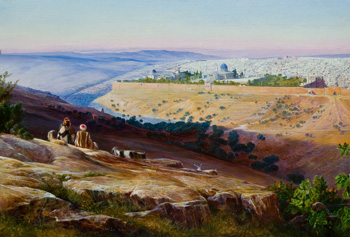
Picnics from high places on Ascension day

The dew that covered the ground on the morning of Ascension Day was held as sacral. The Russians called this dew the tears of the earth that was weeping because of Our Lord's departure. The Dutch rose at dawn to walk through the morning dew in the fields and meadows, a custom called "dew treading." The walk ended at a house or inn where the flowers they had gathered decorated the early morning breakfast tables. (6)
In English counties (especially in Devonshire), the people visited their wells on Ascension Day to "dress" them with colorful flowers, berries, leaves and moss arranged in forms of beautiful religious mosaics. The clergy then blessed these dressed wells, the precious source of their water supply, and said prayers of thanksgiving. (7)
The Greeks went to the sea on the Ascension to collect water from 40 different waves, perhaps symbolic of the 40 days of Easter. In Kydoniac (Asia Minor), the people affectionately bid Our Lord goodbye as they drew the water saying, "Farewell, dear Lord; go on your way." This water was sprinkled in the house as the following prayer was said, "As Christ rose to Heaven, so may calumny, sickness, the evil eye and all other evils rise from our house and disappear." (8)
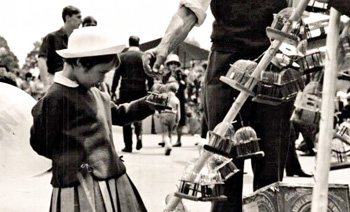
A girl chooses a cricket cage at the Festa del Grillo
In Florence families picnicked in Cascine Park to enjoy the Festival of the Cricket (Festa del Grillo), which celebrated the coming of Spring announced by the chirping Cricket. The children caught crickets in the park and placed them in brightly colored wicker or wire cages. (9)
Ascension foods
The most common dish served on the Ascension Day in many countries was bird or fowl. In the center of the dinner table, the prized dish of partridges, pheasants, pigeons and even crows was placed to honor Our Lord who "flew" to Heaven. In Western Germany, innkeepers and bakers gave their customers bird-shaped pastries.
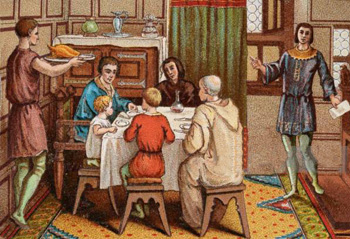
Fowl served at an Ascension Day family feast
On this day dairy products also were prominent, a reminder of Heaven which is prefigured by the Promised Land of milk and honey. In Rome, the milkmen used to give each customer a gift of milk and rennet, which was used to make a rum or brandy-flavored milk pudding called Giuncata. (11)
In Greece, the mountain shepherds had special celebrations in their pastures on this day. The parish priest came to bless the flocks, and then family and friends feasted on rich dishes made of milk and cheese.
Special breads also graced tables on Ascension Day in many places in times of old. The breads and new fruits were blessed after Mass on this day to commemorate Our Lord's last repast in the Cenacle before his Ascension to Heaven. The Russians baked bread in the shape of a ladder, while in parts of France (Franche-Comté), children went from door to door begging for flour to make the traditional puffy donut Beignets. (12)
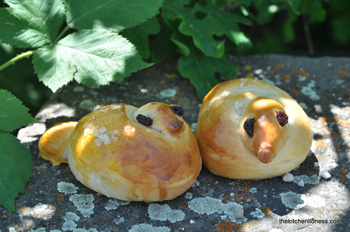
Ascension bread in the shape of birds
In Portugal, the peasants cut sheaves of wheat during the hour between noon and one in the afternoon (the time of day that Our Lord ascended into Heaven) and adorned them with olive branches, poppies, marigolds and rosemary. The sheaves were hung in their houses to ask for prosperity for the coming year. (14)
Many of these charming customs could easily be restored. Families can picnic on fowl meat in a nearby field, meadow or hill, or even the back yard. Processions, pageants and other gay festivities can be included in the celebrations of communities and parishes to honor the sacral and joyous nature of the feast. Let us anticipate the Reign of Mary by asking Her to inspire the souls of Catholics to make this world a reflection of the Kingdom of Heaven to which her Son ascended on this glorious day.
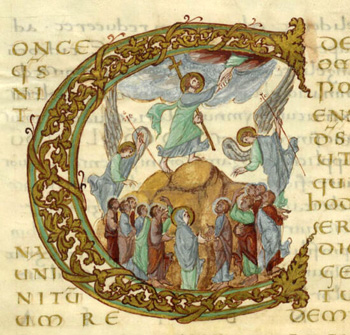
- Francis X Weiser, The Easter Book (San Diego, California: The Firefly Press, 1996), p. 117.
- Richard Thonger, A Calendar of German Customs (London: Oswald Wolff, 1966), p. 45.
- WikiSource - Russian Ascension Day Customs, here
- George A. Megas, Greek Calendar Customs (Athens: B. and M. Rhodis, 1963), p. 126.
- William S. Walsh, Curiosities of Popular Customs and of Rites, Ceremonies, Observances, and Miscellaneous Antiquities (Philadelphia: J. B. Lippincott Company, 1898), p. 68.
- Dorothy Gladys Spicer, Festivals of Western Europe (New York: The H. W. Wilson Company, 1958), p. 143.
- Joanna Bogle, A Book of Feasts and Seasons (Herefordshire, England: Gracewing, 1992), p. 128.
- George A. Megas, Greek Calendar Customs (Athens: B. and M. Rhodis, 1963), p. 126-127.
- Dorothy Gladys Spicer, Festivals of Western Europe (New York: The H. W. Wilson Company, 1958), p. 107.
- WM. Hackwood, Christ Lore: Being the Legends, Traditions, Myths, Symbols, Customs, and Superstitions of the Christian Church (London: Elliot Stock, 1902), p. 175.
- Katherine Burton and Helmut Ripperger, Feast Day Cookbook (Catholic Authors Press, 2005), p. 71.
- E. I. Robson, A Guide to French Fêtes (London: Methuen and Company, 1930), p. 83.
- Dorothy Gladys Spicer, Festivals of Western Europe (New York: The H. W. Wilson Company, 1958), p. 143.
- https://www.portugalnummapa.com/dia-da-espiga/

Posted May 25, 2022
______________________
_____________________
 |
 |
 |
 |
 |
 |


